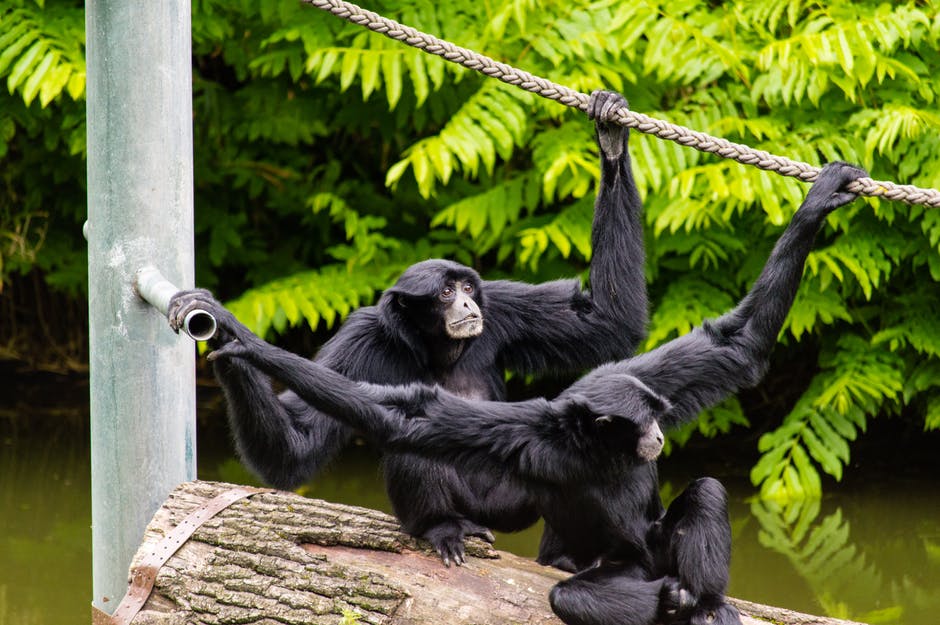Anyone who knows me is familiar with the fact that I absolutely love gibbons! So here are five things you never knew about these super-swingers:
1. They can fly! Ok, so they don’t have wings. And perhaps it isn’t flying in the classic sense. But to anyone who has seen a wild gibbon swing through the canopy, trust me, these guys fly! With exceptionally long arms, no tail, and an adult body weight of around 5.5 (smaller species) to 12 (largest species) kilos, they are perfectly designed to swing through the trees highly efficiently and at incredible speeds. Not just that, their wrists contain ball-and-socket joints which allow for movement in more ways than humans can achieve. Also, their long, muscular hands act like hooks when they are swinging from branch to branch. The suspensory movement that gibbons are so well-adapted to is called ‘brachiation‘.
2. There are 18! That’s right, there are 18 different gibbon species under the genera Nomascus (crested gibbons e.g. image above), Hylobates, Hoolock and Symphalangus (siamangs). Of these, 4 are classified as critically endangered, 11 as endangered and 1 as vunerable to extinction. The recently discovered Nomascus annamensis (discovered in 2010) and fabulously named Skywalker hoolock gibbon or Hoolock tianxing (discovered in 2017) have not been studied well enough for assessment, but it is fair to say that they face similar threats (i.e. primarily habitat loss, fragmentation and degradation, and wildlife trade) as the other species and thus are also threatened by extinction. Gibbons are understudied in comparison to their great ape relatives, even though they include some of the most endangered apes on the planet. For example, the Hainan gibbon (Nomascus hainanus) is considered to be the rarest ape in the world with only about 25 individuals left in the wild.
3. They change colour! Crested gibbons are particularly great colour changers. When they are born they are little blonde beauties that camouflage with their mothers fur. Around 1-2 years of age, they turn black. Then, around 5-6 years of age, females change back to blonde and males stay black with golden cheeks. The age at which colour change starts and the duration of the colour change can vary slightly per individual. When adult males and females have different appearances as gibbons do, this is called sexual dimorphism. Other sexually dimorphic animals include for example orangutans, peacocks, mallard ducks, ostrich, lions and mandrills.
4. They sing! Gibbons live in small family groups. Single females or males will sing to find a mate, and families sing together to bond socially and to protect their territory. The male and female pair in a family group will alternate their singing, like in a duet. The female’s song (or ‘great call‘) is different from the male’s song and in crested gibbons is usually more elaborate, accompanied by a display. Siamangs (Symphalangus syndactylus) are the largest gibbon species. Uniquely, both males and females have a throat sac, which allows them to resonate an even louder song than the other gibbon species.

5. They rarely touch the ground! Gibbons are exclusively arboreal, which means they live high up in the forest canopy and hardly ever come down to the ground. Their whole body is designed for life in the trees. The ground can be dangerous and is where gibbons aren’t able to move as quickly away from predators, so it’s much safer up in the tallest trees.
6. They are messy eaters! Gibbons primarily feed on fruit and leaves, but if you’ve ever seen a gibbon eat, you might notice that a they are messy eaters and a fair amount of food ends up on the ground. However, what might seem like wasted food to us is another animal’s meal. In the wild, animals on the ground will benefit from all this dropped food and the seeds from the dropped plant materials help the forest grow. So gibbons are actually really important seed dispersers that keep the forest ecosystem healthy! This one of the reasons why it is so important to conserve gibbons.

Which fact is your favourite? Please feel free to share in the comment section below!
Learn more about gibbon conservation efforts in Vietnam by Flora and Fauna International and the Endangered Asian Species Trust.
Find out how you can help to protect the Skywalker Hoolock gibbon.
Read about how sanctuaries work together to help conserve endangered primates.

Totally enthralled by this information on the gibbons family -especially the song duets. So rapt to discover Carolyn Thompson’s blog (through your write-up on the Liebster awards) and her hands on field work tracking the Skywalker gibbons. The sound bite she recorded of ‘Bert and Betty’ singing is a triumph. Those soprano pitch perfect notes!!! And the musical score!! Well that’s really extraordinary. I once heard an orchestral score set to whale song and it’s complexity of range and composition. Nature really does rock!
LikeLiked by 1 person